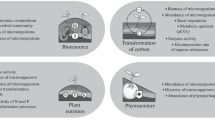Abstract
Research on biological indicators of soil pollution is hampered by soil variability and temporal and spatial fluctuations of numbers of soil animals. These characters on the other hand promote a high biological diversity in the soil. A high diversity combined with persistent soil pollutants increases the chance to select good indicators. However research on these topics is still limited. Examples of specific indicators are the changed arthropod species patterns due to pesticide influence and the changed soil enzyme activity under the influence of specific heavy metals. Another approach is to look for organisms that give a general indication of soil pollution. In this respect the earthworm species Allolobophora caliginosa proved to be sensitive for different types of manure especially pig manure with copper, for sewage sludge, for municipal waste compost and for fly ash. A third way of indication is by organisms accumulating pollutants. For some heavy metals (Cd, Zn), earthworms are very efficient accumulators. More research is needed especially on the specific relation between biological responses and abiotic soil characteristics.
Similar content being viewed by others
References
Anderson, J. M.: 1975, “The Enigma of Soil Animal Species Diversity’, in J. Vanék (ed.), Progress in Soil Zoology, Proceedings of the 5th International Colloquium on Soil Zoology, Prague 1973, Academia publishing house, Prague, 51–58.
Bund, C. F. van de: 1965, ‘Changes in the Soil Fauna Caused by the Application of Insecticides’, Bull. Zool. Agr. Bachic 7, 186–189.
Doelman, P. and Haanstra, L.: 1983, ‘The Influence of Heavy Metals on Soilmicroflora’, Research report Bodembeschermingsreeks nr. 20, Ministery of Public Health and the Environment, 151 pp. (in Dutch).
Edelman, Th.: 1983, ‘Back Ground Values of a Number of Inorganic and Organic Compounds in the Soil of the Netherlands, a Pilot Study’, Research report Bodembeschermingsreeks, Ministry of Public Health and the Environment (in Dutch), (in press).
Edwards, P. J. and Brown, S. M.: 1982, ‘Use of Grassland Plots to Study the Effect of Pesticides on Earthworms’, Pedobiologia 24, 145–150.
Edwards, C. A. and Thompson, A. R.: 1973, ‘Pesticides and the Soil Fauna’, Residue Rev. 45, 1–79.
Freckman, D. W., Slobodkin, L. B., and Taylor, C. E.: 1980, ‘Relation Between Species Lists and Tolerance to Nematicides’, in D. L. Dindal (ed.), Soil Biology as Related to Land Use Practices, Proceedings of the VII International Colloquium of Soil Zoology, Syracuse, 1979, EPA-560/13-80-038, Washington, 391–396.
Ghilarov, M. S.: 1977, ‘Why so Many Species and so Many Individuals Can Coexist in the Soil’, in U. Lohm and T. Persson (eds.), Soil Organisms as Components of Ecosystems, Proceedings of the 6th International Colloquium of Soil Zoology, Ecol. Bulletin (Stockholm) 25, 593–597.
Hoy, J. B.: 1980, ‘Effects of Lindane, Carbaryl, and Chlorpyrifos on Nontarget Soil Arthropod Communities’, in D. L. Dindal (ed.), Soil Biology as Related to Land Use Practices, Proceedings of the VII International Colloquium of Soil Zoology, Syracuse, 1979. EPA-560/13-80-038, Washington, 17–81.
Luepke, N. P.: 1979, ‘Monitoring Environmental Materials and Specimen Banking’, Proceedings of a Int. Workshop W.-Berlin 1978. Nijhoff Publ., The Hague, 132–155.
Ma, W. C.: 1982, ‘The Influence of Soil Properties and Worm-Related Factors on the Concentration of Heavy Metals in Earthworms’, Pedobiologia 24, 109–119.
Ma, W. C., Edelman, Th., Beersum, I. van, and Jans, Th.: 1983, ‘Uptake of Cd, Zn, Pb, and Cu by Earthworms Near a Zinc-smelting Complex: Influence of Soil pH and Organic Matter’, Bull. Environm. Contam. Toxicol. 30, 424–427.
Smith, T. D., McKevan, D. K., and Hill, S. B.: 1980, ‘Effects of Six Biocides on Nontarget Soil Mesoarthropods from Pasture on the Ste. Rosalie Clay Loam, St. Clet. Quebec’, in D. L. Dindal (ed.), Soil Biology as Related to Land Use Practices, Proceedings of the VII International Colloquium of Soil Zoology, Syracuse, 1979. EPA-560/13-80-038, Washington, 56–70.
Wallwork, J. A.: 1970, Ecology of Soil Animals, McGraw-Hill, London.
Zyromska-Rudzka, H.: 1977, ‘Changes in Oribatid Mite Community After Chemical Fertilizer Application in a Meadow’, in U. Lohm and T. Persson (eds.), Soil Organisms as Components of Ecosystems, Proceedings of the 6th International Colloquium of Soil Zoology, Ecol. Bull. (Stockholm) 25, 133–137.
Author information
Authors and Affiliations
Rights and permissions
About this article
Cite this article
Eijsackers, H. Soil fauna and soil microflora as possible indicators of soil pollution. Environ Monit Assess 3, 307–316 (1983). https://doi.org/10.1007/BF00396225
Received:
Issue Date:
DOI: https://doi.org/10.1007/BF00396225




